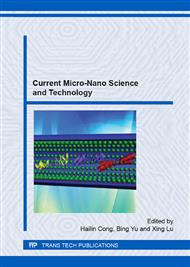[1]
S. W. Park, C. B. Kim, S.Y. Kim, et al., Design of experimental optimization for ULSI CMP process applications. Microelectron (2003)66-488.
DOI: 10.1016/s0167-9317(02)00932-2
Google Scholar
[2]
Y.L. Liu, K.L. Zhang, F. Wang, et al., Investigation on the final polishing slurry and technique of silicon substrate in ULSI. Microelectron (2003)66-438.
DOI: 10.1016/s0167-9317(02)00908-5
Google Scholar
[3]
P. B. Zantye, A. Kumar, A. K. Sikder, Chemical mechanical planarization for microelectronics applications. Mater. (2004)45-89.
Google Scholar
[4]
C. C. Chen, L.S. Shu, S.R. Lee, Mechano-chemical polishing of silicon wafers. J. Mater. Process. (2003)140-373.
Google Scholar
[5]
J. T. Abiade, Characterization of the chemical effects of ceria slurries for dielectric chemical mechanical polishing. University of Florida, USA (2004).
Google Scholar
[6]
J. F. Luo, D. A. Dornfeld, Material Removal Mechanism in Chemical Mechanical Polishing: Theory and Modeling. IEEE Trans. Semicond. Manufac. (2001)12-14.
DOI: 10.1109/66.920723
Google Scholar
[7]
B. Mullany, G. Byrne, The effect of slurry viscosity on chemical–mechanical polishing of silicon wafers. J. Mater. Process. Technol. (2003)28-132.
DOI: 10.1016/s0924-0136(02)00205-4
Google Scholar
[8]
N. H. Kim, Y. J. Seo, W. S. Lee, Temperature effects of pad conditioning process on oxide CMP: Polishing pad, slurry characteristics, and surface reactions. Microelectron (2006)83-362.
DOI: 10.1016/j.mee.2005.10.004
Google Scholar
[9]
Y. L. Liu, K. L. Zhang, F. Wang, et al., Study on the cleaning of silicon after CMP in ULSI. Microelectron (2003)66-433.
Google Scholar
[10]
H. Lei, J. B. Luo, CMP of hard disk substrate using a colloidal SiO2 slurry: preliminary experimental investigation. Wear (2004)257- 461.
DOI: 10.1016/j.wear.2004.01.017
Google Scholar
[11]
C. H. Zhou, L. Shan, H. J. Robert, et al., Fluid pressure and its effects on chemical mechanical polishing. Wear (2000)253-430.
DOI: 10.1016/s0043-1648(02)00155-2
Google Scholar
[12]
C. Srinivasa-Murthy, D. Wang, S. P. Beaudoin, et al., Stress distribution in chemical mechanical polishing. Thin Solid Films (1997)308–309, 533.
DOI: 10.1016/s0040-6090(97)00433-1
Google Scholar
[13]
R. Vacassy, R. J. Flatt, H. Hofmann, Synthesis of Microporous Silica Spheres. J. Colloid Interface (2000)227-302.
DOI: 10.1006/jcis.2000.6860
Google Scholar
[14]
I. Zarudi, B. S. Han. Deformation and material removal rate in polishing silicon wafers. J. Mater. Process. Technol. (2003)140-641.
DOI: 10.1016/s0924-0136(03)00754-4
Google Scholar
[15]
T. Hoshino, Y. Kurata, Y. Terasaki, et al., Mechanism of polishing of SiO2 films by CeO2 particles. J. Non-Cryst. Solids (2001)129-283.
DOI: 10.1016/s0022-3093(01)00364-7
Google Scholar
[16]
X. L. Song, N. Jiang, Y. K. Li, et al., Synthesis of CeO2-coated SiO2 nanoparticles and dispersion stabiLity of their suspension,Materials Chemistry and Physics, (2008)128-135.
DOI: 10.1016/j.matchemphys.2008.01.042
Google Scholar
[17]
M. S. Tsai, Powder synthesis of nanograde cerium oxide via homogenous precipitation and its polishing performance. Mater. (2004)110-132.
DOI: 10.1016/j.mseb.2003.11.024
Google Scholar
[18]
A. Rajendran, Y. Takahashi, M. Koyama, et al., Tight-binding quantum chemical molecular dynamics simulation of mechano-chemical reactions during chemical–mechanical polishing process of SiO2 surface by CeO2 particle. Appl. Surf. (2005)34-244.
DOI: 10.1016/j.apsusc.2004.09.126
Google Scholar
[19]
X. L. Song, S. T. Huang, B. Y. Gong, et al., Synthesis of γ-Al2O3/CeO2 coated nanoparticles and dispersion stability of their suspension,Integrated Ferroelectrics (2013)76-87.
Google Scholar
[20]
Z. Y. Lu, Investigation of slurry systems in metal and dielectric chemical mechanical polishing. Clarkson University, Germany (2004).
Google Scholar
[21]
Cook, L. M. Loncki, S. B. Brancaleoni, et al., Activated polishing compositions. US 5480476 (1996).
Google Scholar
[22]
C. S. Picardi, M. M. Tanase, Chemical mechanical polising composition. WO 99/08838 (1999).
Google Scholar
[23]
X. L. Song, D. F. Liu, Y. M. Zhang, et al., Dispersion Stability of CeO2-coated SiO2 Composite Particles and Dispersion Mechanism. Integrated Ferroelectrics (2011)146-159.
DOI: 10.1080/10584587.2011.576941
Google Scholar
[24]
I. Y. Lee, S. T. Kim, Y. J. Cho, et al., Polishing slurry comprising silica-coated ceria. WO 03/016424 (2003).
Google Scholar
[25]
H. P. Klug, L. E. Alexander, X-Ray diffraction procedure for polycrystalline and amorphous material. Wiley, New York (1974).
Google Scholar
[26]
K. M. S. Khalil, L. A. Elkabee, B. Murphy, Formation and characterization of different ceria/silica composite materials via dispersion of ceria gel or soluble ceria precursors in silica sols. J. Colloid Interface (2005)287-534.
DOI: 10.1016/j.jcis.2005.02.041
Google Scholar


